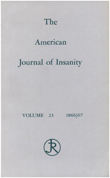Gender differences in personality disorders
Abstract
OBJECTIVE: The aim of this study was to assess gender differences in personality disorders. Since heterogeneity of axis I diagnoses could introduce variability in the assessment of axis II diagnoses, the authors studied a group of patients with a primary diagnosis of major depression. METHOD: A total of 316 patients were evaluated with the Personality Diagnostic Questionnaire--Revised, a self-rating measure, or the Structured Clinical Interview for DSM-III-R Personality Disorders (SCID-II), a clinician-rated instrument, or both. Axis II disorders were assessed with the Personality Diagnostic Questionnaire-- Revised for 288 patients with major depression. The SCID-II was administered to 117 subjects, with an additional 95 subjects receiving the SCID-II for cluster B diagnoses only. RESULTS: The mean 17-item Hamilton Depression Rating Scale scores for 108 men (mean age = 39.28 years) and 208 women (mean age = 39.11) were 19.0 (SD = 3.8) and 19.6 (SD = 6.9), respectively. Men were significantly more likely than women to meet criteria for narcissistic, antisocial, and obsessive-compulsive personality disorders as measured by the Personality Diagnostic Questionnaire--Revised and for narcissistic and obsessive-compulsive personality disorders as measured by the SCID-II. CONCLUSIONS: These findings are consistent with those of previous studies showing a greater prevalence of antisocial and narcissistic personality disorders in men. In contrast with other investigations, however, neither the Personality Diagnostic Questionnaire--Revised nor the SCID-II revealed a higher prevalence of any personality disorder in women.
Access content
To read the fulltext, please use one of the options below to sign in or purchase access.- Personal login
- Institutional Login
- Sign in via OpenAthens
- Register for access
-
Please login/register if you wish to pair your device and check access availability.
Not a subscriber?
PsychiatryOnline subscription options offer access to the DSM-5 library, books, journals, CME, and patient resources. This all-in-one virtual library provides psychiatrists and mental health professionals with key resources for diagnosis, treatment, research, and professional development.
Need more help? PsychiatryOnline Customer Service may be reached by emailing [email protected] or by calling 800-368-5777 (in the U.S.) or 703-907-7322 (outside the U.S.).



